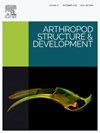That's how they roll: skeletal mechanics of enrolment and the importance of hydrostatic support in terrestrial isopods
IF 1.3
3区 农林科学
Q2 ENTOMOLOGY
引用次数: 0
Abstract
Various arthropods can roll into a ball for protection. In terrestrial isopods (Oniscidea), this ability has likely evolved independently in different lineages. In this work, comparative imaging of extended and rolled isopods using micro-computed tomography of rapidly frozen individuals was coupled with live imaging. The results show that the points of rotation between consecutive body segments are positioned dorsolaterally and do not represent fixed joints, as previously assumed. Ridges at the anterior and posterior edges of consecutive dorsal plates (tergites) lean against each other at these points, allowing consecutive body segments to rotate relative to each other. Conglobating terrestrial isopods have shorter sternal plates than non-rollers. As a result, the sternal plates overlap only as an isopod rolls, forming furrows that accommodate the walking legs. The sternal plates are able to bend along a flexible suture at their midline, which is pulled inward during rolling. Both conglobating and non-conglobating terrestrial isopods are capable not only of ventral but also lateral flexion, which requires the separation of the surfaces that are in contact during rolling. The observed diversity of movements can be explained by the use of hydrostatic support provided by the hemocoel. The essential role of this hydrostatic support in the movement of isopods is demonstrated.
这就是它们的滚动方式:骨骼力学的注册和陆地等足类动物的流体静力支撑的重要性
各种节肢动物可以滚成一个球来保护自己。在陆生等足类动物(蛇足纲)中,这种能力可能在不同的谱系中独立进化。在这项工作中,使用快速冷冻个体的微型计算机断层扫描对伸展和滚动等足类进行了对比成像,并结合了实时成像。结果表明,连续身体节段之间的旋转点位于背外侧,而不是像之前假设的那样代表固定关节。连续背板前后边缘的脊状物在这些点上相互靠靠,使连续的身体节段相互相对旋转。联合陆生等足类动物的胸骨板比非滚轴类动物短。因此,只有当等足类动物滚动时,胸骨板才会重叠,形成凹槽,以容纳行走的腿。胸骨板能够沿其中线处的柔性缝合线弯曲,在滚动过程中向内拉。聚类和非聚类陆地等足类不仅能够进行腹侧弯曲,而且还能够进行侧向弯曲,这需要在滚动过程中分离接触的表面。观察到的运动的多样性可以通过使用由血膜提供的流体静力支持来解释。这种流体静力支持在等足类动物运动中的重要作用得到了证明。
本文章由计算机程序翻译,如有差异,请以英文原文为准。
求助全文
约1分钟内获得全文
求助全文
来源期刊
CiteScore
3.50
自引率
10.00%
发文量
54
审稿时长
60 days
期刊介绍:
Arthropod Structure & Development is a Journal of Arthropod Structural Biology, Development, and Functional Morphology; it considers manuscripts that deal with micro- and neuroanatomy, development, biomechanics, organogenesis in particular under comparative and evolutionary aspects but not merely taxonomic papers. The aim of the journal is to publish papers in the areas of functional and comparative anatomy and development, with an emphasis on the role of cellular organization in organ function. The journal will also publish papers on organogenisis, embryonic and postembryonic development, and organ or tissue regeneration and repair. Manuscripts dealing with comparative and evolutionary aspects of microanatomy and development are encouraged.

 求助内容:
求助内容: 应助结果提醒方式:
应助结果提醒方式:


